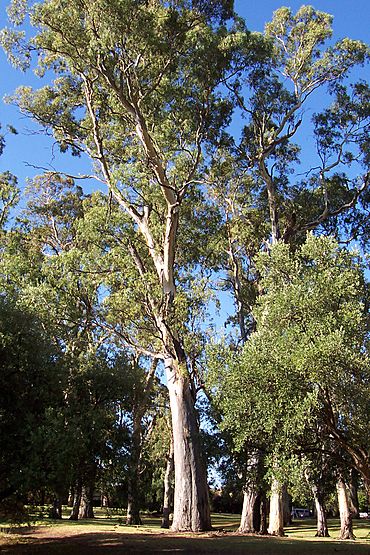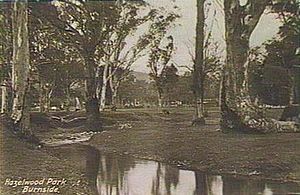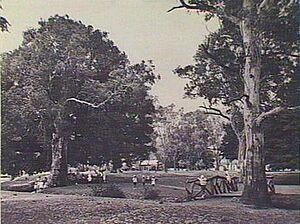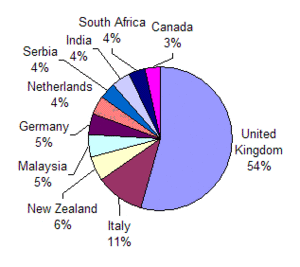Hazelwood Park, South Australia facts for kids
Quick facts for kids Hazelwood ParkAdelaide, South Australia |
|||||||||||||||
|---|---|---|---|---|---|---|---|---|---|---|---|---|---|---|---|

Old eucalyptus trees, characteristic of the area
|
|||||||||||||||
| Established | 1848 | ||||||||||||||
| Postcode(s) | 5066 | ||||||||||||||
| LGA(s) | City of Burnside | ||||||||||||||
| State electorate(s) | Bragg | ||||||||||||||
| Federal Division(s) | Sturt | ||||||||||||||
|
|||||||||||||||
Hazelwood Park is a lovely suburb in Adelaide, South Australia. It's home to about 1,700 people and is located about 5 kilometres east of Adelaide's city centre.
The main attraction here is Hazelwood Park, a big suburban park. It marks the start of the flat Adelaide Plains before the Adelaide Hills begin. Inside the park, you'll find the Burnside Swimming Centre, which is super popular in summer! Most of Hazelwood Park is made up of homes, but there's also a small shopping area along Glynburn Road. Europeans first settled this area in 1848.
The suburb is split in half by Greenhill Road. North of the road are houses and the park. To the south and east, you'll find the foothills of the Mount Lofty Ranges with more homes. Hazelwood Park is bordered by Knightsbridge Road to the north, Glynburn Road to the east, Cooper Place to the south, and Devereux Road to the west.
Contents
History of Hazelwood Park
Before Europeans arrived, the land that is now Hazelwood Park belonged to the Kaurna people. Their traditional lands stretched from Port Broughton to Cape Jervis.
The area, including parts of today's Hazelwood Park, was first known as Knightsbridge. This village was planned in 1848. Captain Hall designed it by simply dividing the land into eight blocks. Much of this land was sold to people who cut down trees, as the area had thick bushland.
The first house in the suburb, built in 1854, still stands today at 12 Hazelwood Avenue. It was built by George Taylor, a local grocer. This house, called Knightsbridge House, was special because its ground floor was partly underground. This helped keep it cool during hot Australian summers.
Orphanage and Farm Life
An orphanage was set up on the land by the Sisters of St. Joseph, a Catholic group. They cared for many children between 1875 and 1887. People said the Sisters worked very hard for the children. Later, the orphanage moved, and the land became a large dairy farm run by the Coote family from 1888 to 1950.
Another part of today's Hazelwood Park, south of Greenhill Road, was called Linden. This name is still used for the nearby suburb of Linden Park. Linden had some of the best farming land around.
Road Plans and Changes
After World War II, Adelaide was growing fast. There were plans to build a new highway to replace the old, winding Mount Barker Road. One idea was the Burnside-Crafers Highway, which would have gone through Hazelwood Park. The local council even widened Linden Avenue to prepare for it. However, this plan was not chosen. Linden Avenue became a very wide road in a quiet suburb. To slow down traffic, the council added a large garden strip in the middle of the road in 2005.
The Park's Journey
The actual Hazelwood Park land was given to the State Government in 1915. It was made a "pleasure resort," meaning a place for fun and relaxation. This land came from the old "Hazelwood" estate, owned by the Clark family. They had bought the property in 1853 and renamed it "Hazelwood."
Years later, the Burnside Council wanted to take over the park. The Mayor, George Bolton, dreamed of building an Olympic-sized swimming pool there. After much effort, the council finally got the park in 1963. They promised to keep the name "Hazelwood" and look after the park well. In 1966, the George Bolton Swimming Centre opened with three pools. It's still open today and was updated in 1996.
Hazelwood Park is now a State Heritage Item. This means it's an important historical place. It's special because it was one of the first four places to be named a "National Pleasure Resort" in 1915. It's also linked to the Clark family, who were important in public life and helped poor children.
Nature and Environment
Hazelwood Park originally had lots of Blue and Red gum trees, especially north of Greenhill Road. South of the road, there was a type of forest called 'Black Forest'. The park itself is a great example of the remaining Blue and Red Gum trees.
Today, the area has many trees, but some are not native to Australia. The Burnside Council is now working hard to plant and keep native plants. This is different from the past, when European plants were often preferred.
First Creek flows through the suburb and the park. It starts in the Mount Lofty Ranges and Adelaide Hills. This creek is seasonal, meaning it often dries up in summer. It flows from Waterfall Gully, through Burnside, into Hazelwood Park, and then joins the River Torrens near the Adelaide Botanical Gardens. Besides Hazelwood Park, another small park is the Ray Cooper Gardens on Linden Avenue.
Getting Around
Most people in Hazelwood Park use cars to get around. On average, each household has about 1.5 cars. This means most residents drive to work. Traffic is usually light, except during busy times on Greenhill and Glynburn Roads. You can usually reach the city centre in about ten minutes by car.
Like most Adelaide suburbs, the main roads have a speed limit of 60 km/h, and side streets are 50 km/h. The roads in Hazelwood Park mostly follow a grid pattern.
Only a small number of people take the bus to work. Adelaide Metro buses are the only public transport here. Buses like the 142 or 147 go into or near the suburb. Buses usually run every 30 minutes on weekdays. Because so many people use cars, bus routes are not as frequent as in some other parts of Adelaide.
People of Hazelwood Park
In 2021, about 1,953 people lived in Hazelwood Park. Slightly more than half of the people are female. Most residents (68.2%) were born in Australia, and the average age is 43.
Hazelwood Park has a well-educated population, with over 40% having a degree or diploma. Many people work in education, cafes and restaurants, health services, finance, and business. The average household income is quite high, over $2,300 per week.
Hazelwood Park is a stable place for families. Many homes have children and their parents. While most homes are detached houses, more attached homes (like townhouses) are being built.
Fun Things to Do
The biggest attraction in Hazelwood Park is the park itself and the Burnside Swimming Centre. The swimming centre is an outdoor pool, so it's only open in summer. It's a very popular spot on hot days!
First Creek flows through the park and is dammed to create a pond. This is a favorite place for kids to feed the ducks, and families often relax by the water. There's a playground in the north-east part of the park, along with tables and barbecues for picnics. The park is quite large and has huge, old Gum trees that you can see from far away. Even though it has good facilities, it's usually not as busy as the smaller Tusmore Park nearby. Hazelwood Park also hosts a very popular carols night every December.
Hazelwood Park has a few small shopping areas, especially around the Glynburn and Greenhill Road roundabout. This area used to be known as The Feathers, and some shops still use that name. The shops along Greenhill Road are part of the Feathers Shopping Center. Across the road, you'll find the Feathers Hotel, which is in the neighbouring suburb of Burnside. For bigger shopping trips, people usually go to nearby Burnside Village, Marryatville Shopping Center, or Norwood Parade.
.







